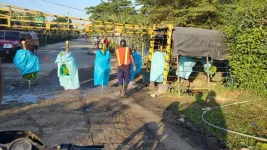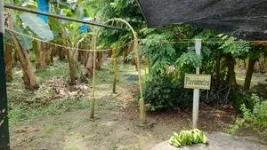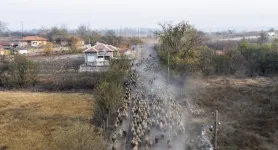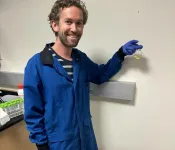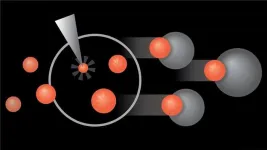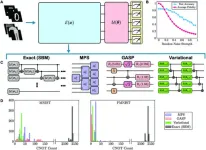(Press-News.org) There’s no cure for a fungal disease that could potentially wipe out much of global banana production. Widespread adoption of cement paths, disinfection stations, and production strategies could net 3-4 USD of benefits for each dollar invested in Colombia.
Hundreds of millions of dollars in banana exports from Colombia are at risk due to a fungal disease best known as Tropical Race 4 (TR4). First detected in Asia in the 1990s, the Fusarium fungus that causes the disease arrived in Colombia in 2019, completing its inevitable global spread to South America, the last major banana production continent that remained TR4-free. Researchers are confident a solution will be found but until then, slowing the spread is the only effective strategy.
The good news is that simple, effective measures are already happening in Colombia. These include building cement paths between banana plots, fencing them, and installing disinfectant stations at farm entry points. Measures like this are worth the investment. Researchers at the Alliance Bioversity International and CIAT found banana producers can expect a 3-4 USD return per dollar invested.
“The solutions are not extremely technical, they just require money and awareness,” said Thea Ritter, an Alliance researcher. “We found the potential benefits are very large. We urge industry and the government to continue making the needed investments and accelerate ongoing efforts to educate producers and communities about TR4. If it spreads more, it will devastate local and national economies.”
The research was published Oct. 30 in PLOS ONE, in likely the first socioeconomic study of its kind in the Americas. Ritter and colleagues researched TR4 in the Colombian departments of Antioquia and Magdalena, two large export-oriented banana production areas because they found no farm-level research on TR4 in the country. Results found considerable, little-understood local and cultural impacts of the TR4 threat. These intangible details of the study paint a broader picture of what banana crop decimation could mean for the thousands of livelihoods that depend on the industry.
Unstoppable race
When TR4 infects soils, for all practical purposes, it is there to stay. At least 4 decades are needed for it to go away. Almost all bananas planted in infected soils will die. This includes the Cavendish, the world’s most popular fruit, and many plantains that are staples of tropical diets. Some 80% of all bananas planted globally are susceptible to TR4. The disease also affects tomatoes, sweet potatoes, legumes and curcubits (the gourd family), limiting alternatives for farmers who may have to switch cultivars to keep producing food.
“Even if you plant crops like rice that are not susceptible to TR4, the risk of transmission remains because the soils remain infected,” said Diego Álvarez, a co-author and Alliance researcher.
TR4 spreads in several controllable ways. One primary driver is simply dirty boots – stepping on TR4-infected soils and then walking to TR4-free soils is one easy way to spread the disease. Disinfectant stations, fences and cement paths effectively reduce this risk.
Other transmission methods require a bit more effort, including changes in production practices. These include disposing of infected bananas in waterways, as TR4 can spread through water. Soil erosion, containable by cement paths and effective drainage systems, is also a TR4 superspreader. Additionally, trucks that transport bananas are not routinely disinfected, suggesting that TR4 awareness and investment necessary beyond producers.
Ritter points to a common propagation practice as one of the biggest threats – the use of corms (the “baby” banana plants that grow at the base of banana trees) to sow new plots. Farmers need to either effectively screen corms for TR4 before transplanting them, or rely on the more costly, certified disease-free plants.
“Awareness of the disease is high; we found that 99% percent of the farmers we interviewed knew about it and the associated threats,” Ritter said. “But there is much lower awareness of the threat posed by using corms. Farmer training – and investment strategies – need a greater focus on this issue for more effective containment.”
Colombia in the race
Colombia is fortunate because its government, banana industry and grower cooperatives are organized, aware of the TR4 threat, and taking action, researchers said.
“We have a good environment in Colombia’s banana sector to slow the transmission of TR4,” said Leslie Estefany Mosquera, a co-author and Alliance researcher. “But we need more awareness and commitment from policymakers to increase the required biosecurity measures. More policymakers need to be made aware of the urgency of the issue and to dedicate the resources needed.”
Challenges to providing them enough information, however, remain. Because TR4 could literally alter Colombia’s agricultural landscape, not enough people close to the problem are willing to openly speak about it.
How TR4 impacts household livelihoods
Fusarium represents considerable losses for producers in Magdalena, where producers must group in cooperatives to sell their bananas abroad and production areas are not as large as in Antioquia. Banana grower families in Magdalena would be directly affected by the presence of Fusarium through the loss of large portions of land that now cannot produce bananas for marketing, which reduces their income, affects their livelihoods and harms their food security. In Colombia, finding a banana plant infected with Fusarium means losing 2.56 hectares of production, on average, due to the quarantine regulatory area established in this country. This, in a region where at least half of the producers have a production area of less than 3 hectares, leaves the average producer fearful of what could happen if the situation gets out of control and the plantations of several producers are affected.
Beyond Magdalena producers, other actors in the banana value chain in Colombia anticipate wide-ranging impacts from TR4. The disease is expected to cause a decline in banana production, reducing the availability of one of the country's staple foods. This reduction in production could increase prices and limit access to bananas, particularly affecting low-income households that rely on bananas as an affordable food source. The economic ripple effect extends to labor as well; with plantations potentially being abandoned or destroyed, job losses loom. Many families that depend on plantation work for their livelihoods may experience a significant reduction in income, further straining their ability to secure food and meet basic needs.
Touching the intangibles
It’s hard to understate the importance of on-the-ground research of any major threat affecting farmers. National and regional studies effectively capture the big picture – such as modeling the spread of TR4 and the potentially massive hit that agricultural GDP will take if the disease spreads unchecked. But what of the people on the ground whose livelihoods, culture and communities are at existential risk?
Most farmers are willing to talk about TR4 – anonymously and individually with researchers. But they are highly reluctant to report the detection of TR4 on their lands or communities. This is because TR4 scares away investors and farmers would see access to credit and other financial or technical support dry up. The TR4 stigma may lead to under-reporting of the disease’s spread if systematic monitoring is not in place. It is also of little help that farmer cooperative leaders, who likely have deeper understanding of TR4 at wider scales, did not talk to researchers for this study.
“Policymakers should also address the disincentives around discussing TR4,” said Ritter. “We all need as much information as possible about where the disease is spreading and how it is impacting farmers to first, deploy mitigation strategies for effective containment and second, to support farmers whose incomes could be destroyed by TR4.”
Researchers also identified major concerns that aren’t easily capture by cost-benefit-analysis or GDP projections. Bananas are deeply embedded in Colombia culture, as a staple food, a backbone of farmer income, and national identities. TR4 has the potential to disrupt traditional farming practices and community structures, which could lead to social upheaval, including the strong social ties and traditions built around banana-based livelihoods. Ultimately, traditional knowledge in communities related to banana harvesting and associated agricultural practices are at risk.
Ritter said, “We need to understand that many thousands of people’s lives, communities and cultures are threatened by TR4 and to take this seriously.”
END
Stalling a disease that could annihilate banana production is a high-return investment in Colombia
2024-11-08
ELSE PRESS RELEASES FROM THIS DATE:
Measurements from ‘lost’ Seaglider offer new insights into Antarctic ice melting
2024-11-08
New research reveals for the first time how a major Antarctic ice shelf has been subjected to increased melting by warming ocean waters over the last four decades.
Scientists from the University of East Anglia (UEA) say the study - the result of their autonomous Seaglider getting accidentally stuck underneath the Ross Ice Shelf - suggests this will likely only increase further as climate change drives continued ocean warming.
The glider, named Marlin, was deployed in December 2022 into the Ross Sea from the edge of the sea ice. Carrying a range of sensors to collect data on ocean processes that are important for climate, it was programmed to travel northward into ...
Grant to support new research to address alcohol-related partner violence among sexual minorities
2024-11-08
Navigating the intersection of alcohol use and intimate partner violence amongst young couples is not an easy journey, and for bisexual+ couples, the road may be even more winding.
“No study has examined the extent to which alcohol use increases intimate personal violence among bisexual+ young adults or daily experiences unique to them. Our study will look at factors such as minority stressors that may lead to alcohol-related partner violence,” said Meagan Brem, director of the Research for Alcohol and Couple’s Health Lab at Virginia Tech.
Alcohol use and intimate partner violence - defined as any action in a ...
Biodiversity change amidst disappearing human traditions
2024-11-08
A Branco Weiss Fellowship – Society in Science has been awarded to Dr Gergana Daskalova. The fellowship funds Daskalova’s research project “Biodiversity change amidst disappearing human traditions and changing socio-economics”. She joins the Department of Conservation Biology at the University of Göttingen to work together with Professor Johannes Kamp. The five-year fellowship, which is worth over €530,000, will enable Daskalova to investigate the ecological and human fingerprints of land abandonment. Considering the question from both a local and a global perspective, Daskalova’s research will reveal what happens to nature when people leave, ...
New approaches to synthesize compounds for pharmaceutical research
2024-11-08
Junior Professor Johannes Walker, University of Göttingen, has been awarded an Exploration Grant from the Boehringer Ingelheim Foundation. Walker teaches and carries out research at the Institute for Organic and Biomolecular Chemistry. The award of 180,000 euros will enable Walker and his team to develop new approaches to synthesizing new compounds.
“The aim of our project is to develop new strategies for the synthesis of a particular group of new chemical compounds,’ Walker explains. These compounds are called saturated polycyclic molecules. They are structurally complex ...
Cohesion through resilient democratic communities
2024-11-08
A new EU joint research project led by the University of Göttingen will explore how migration, demographic change and current crises are affecting social cohesion and democratic structures in Europe. A key objective is to find out how resilient democratic structures can strengthen local communities in times of profound demographic change. The project “Identities - Migration - Democracy (We-ID)” has been awarded funding of around three million euros over three years by the European Union.
European societies are undergoing a profound demographic transformation: falling birth rates, rising life expectancy and migration are increasingly ...
UC Santa Cruz chemists discover new process to make biodiesel production easier, less energy intensive
2024-11-08
UC Santa Cruz chemists have discovered a new way to produce biodiesel from waste oil that both simplifies the process and requires relatively mild heat. This discovery has the potential to make the alternative fuel source much more appealing to the massive industrial sectors that are the backbone of the nation’s economy.
In 2022, the U.S. transportation sector alone used about 3 million barrels of diesel per day, accounting for about 75% of total consumption of the fuel in this country. That same year, ...
MD Anderson launches Institute for Cell Therapy Discovery & Innovation to deliver transformational new therapies
2024-11-08
HOUSTON ― The University of Texas MD Anderson Cancer Center today announced the launch of its Institute for Cell Therapy Discovery & Innovation, which will build upon longstanding MD Anderson clinical and research expertise to lead the world in developing and advancing impactful cell therapies for patients in need.
The institute will bring together top scientists and clinicians to lead exceptional discovery, translational and clinical research that will deliver new insights in immunology and cell engineering, fueling the creation of transformational new treatments that can be rapidly adapted to address emerging needs in cancer, autoimmune diseases, infections ...
New quantum encoding methods slash circuit complexity in machine learning
2024-11-08
A recent study by researchers from CSIRO and the University of Melbourne has made progress in quantum machine learning, a field aimed at achieving quantum advantage to outperform classical machine learning. Their work demonstrates that quantum circuits for data encoding in quantum machine learning can be greatly simplified without compromising accuracy or robustness. This research was published Sept.12 in Intelligent Computing, a Science Partner Journal.
The team’s results, validated through both simulations and experiments on IBM quantum devices, show that their innovative encoding methods reduced circuit ...
New research promises an unprecedented look at how psychosocial stress affects military service members’ heart health
2024-11-08
A University of Massachusetts Amherst researcher will examine the role of cumulative psychosocial stress – as well as race, ethnicity and gender – among U.S. military personnel to gauge their impact on cardiovascular health and healthcare utilization.
The study is funded with a $1 million grant from the Defense Health Agency, part of the Department of Defense (DoD). The findings will help the military develop programs for health promotion and health readiness for active duty and Reserve/National ...
Faster measurement of response to antibiotic treatment in sepsis patients using Dimeric HNL
2024-11-08
The biomarker human neutrophil lipocalin HNL, which was previously shown to be a useful indicator of bacterial infections, may also in the form of Dimeric HNL be used to effectively monitor the success of antibiotic treatment in sepsis. The first promising results in this regard were published in 2019 and now the research group has confirmed these results in a larger study. The study is published in the journal PLOS ONE.
Sepsis, the costliest disease to health care, is a life-threatening condition with high mortality if not diagnosed and ...
